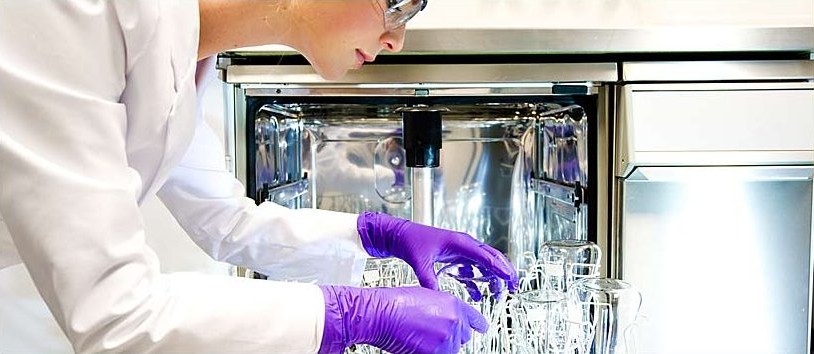Automated Cleaning
What are the advantages of automated cleaning?
- Glass breakage is less common in automated cleaning than in manual cleaning – with the prerequisite that the laboratory glass items are placed correctly in a suitable rinsing basket (with appropriate insert). Glass breakage is not just annoying. It can also result in injuries.
- The exposure of staff is much lower (vapours from disinfecting agents, allergies, dermatitis, injuries, low danger of contamination).
- If required the machine preparation can be standardised, validated and documented.
- The glass dries quickly and well because of the high rinsing temperature.
What needs to be taken into account when placing the items?
- Correct loading of the rinsing basket and the appropriate insert for the laboratory glass are prerequisites for residue-free cleaning. The glass appliances should neither move in the rinsing basket nor touch one another.
- The filling level of the cleaner container must be checked regularly and empty containers changed if required. With most machines an empty level is displayed automatically.
- As the laboratory glass is contaminated, gloves should be worn.
Which basket (machine insert) is the correct one?
- There are suitable baskets with inserts for many varieties of laboratory glass appliances. For conical flasks, injector baskets with special brackets and a spray device inside the flask should be used. Pipettes are cleaned thoroughly in injector baskets which are suitable for the special shape of the pipettes and the tight volume. Measuring cylinders can be cleaned effectively in a basket and insert with “elastic” spring hooks which ensure a solid fixed position depending on the size of the glass item.
What represents optimum basket loading?
- The baskets or inserts should not be packed too tightly. If objects or vessels lie above one another, it may result in inadequate cleaning or damage to the glass. In addition this can also result in the spreading of process chemicals right up to the final rinse which once again has an effect on the residues. It is necessary to use the baskets which are intended for the items to be washed. Smaller objects can be placed in a suitable insert basket in order to prevent any “flying around” and thus potential damage to the items being washed in the machine.
What needs to be taken into account when unloading?
- Once the cleaning cycle has been completed, the machine should be emptied as soon as possible.
- Thick glass cools more slowly so it could still be hot on removal!
- If drying in the machine has not been adequate, it is easiest and best to remove the rinsing basket from the machine, put it down and allow the laboratory glass items to dry and cool off with the air before placing them in a compartment drier if necessary.
- Washing arms and strainers must be cleaned if required. The door of the washer should be kept open in a slightly tilted position.
What should be done when there are deposits in the machine/on the cleaned items?
- Visible deposits inside the machine and/or on the cleaned items require immediate and thorough cleaning of the machine and items to be cleaned. The causes of the deposits must be established and rectified accordingly.

